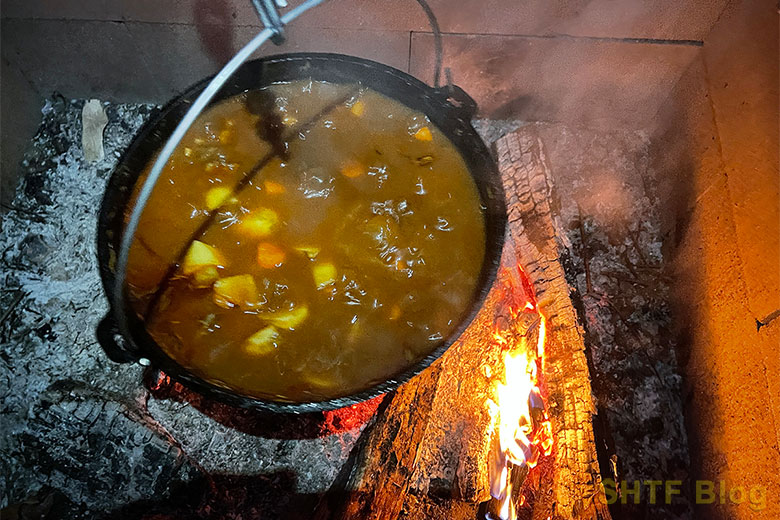
Making Dutch oven beef stew is not particularly difficult. Making it over a campfire, however, requires a bit more hands-on monitoring and playing with the fire.
I created this recipe one evening when we were entertaining friends for dinner. I modified it slightly from other, traditional beef stew recipes. It was a great dinner choice because we could chat around a fire while I “worked” in the kitchen.
Note that I have doubled the recipe in this article. All of the pictures reflect that. I did this because I was cooking for so many people; that and left over beef stew is often as good if not better than the day it was made.
When this recipe is doubled, it all fits perfectly into a 12″ (8 quart) deep Dutch oven. I bought mine on Amazon, but it’s also available at Cabela’s. Stir careful over the fire as the stew sits near the rim of this Dutch oven.
- 8 QT. DEEP CAMP DUTCH OVEN. The Lodge portable “camp stove” is the pot that does it all. The flanged lid holds hot coals and inverts for use as a griddle. The integral legs allow the oven to sit perfectly over the campfire.
- PRE-SEASONED COOKWARE. A good seasoning makes all the difference. Lodge provides pre-seasoned cookware with no synthetic chemicals; just soy based vegetable oil. The more you use your iron, the better the seasoning becomes.
What I like about this recipe is that it’s all confined to one pot. That makes cleanup easy, which is particularly important when you are cooking outside or camping. This is the perfect recipe for a family camping trip.
Prepping the Fire and Preparing Ingredients
If you’ve never cooked over a fire before, welcome to the fun! The process begins with your fire. You need time to build up a small bed of hot coals to cook over. I had my fire burning for almost an hour before I started cooking the stew over it. If time is tight, you can speed things up by using a charcoal chimney and lump charcoal.
I don’t typically recommend using charcoal briquettes for cooking food but in this case they could work fine because the food is enclosed in the Dutch oven. I did not include the fire time in the recipe’s prep time.
Once your fire is started you should begin prepping your ingredients. You will not want to do this while trying to tend the fire as you begin cooking because you won’t have enough arms and hands. Unless you have a sous-chef helping out, help yourself by getting everything ready to go in advance.
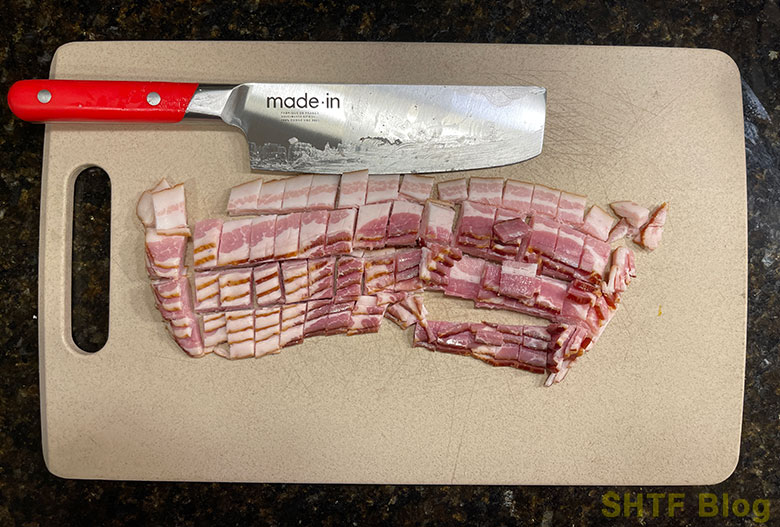
In my case, getting the ingredients prepped started with the bacon, which is the first ingredient to go into the Dutch oven. I prepped everything in my kitchen and cooked outside. I used my favorite brand of knives, Made In, for all of the cutting, but if you’re working in the field or camping, using a lower quality knife makes sense.
The Campfire Cooking Process
You will need the ability to adjust the heat. That means moving coals around and/or changing the height of your Dutch oven. I hang my Dutch oven from my concrete block outdoor cook station, but you can also use a campfire tripod if you need a more mobile, easier system. Where this is all cooked inside a single Dutch oven, a tripod is all you really need.
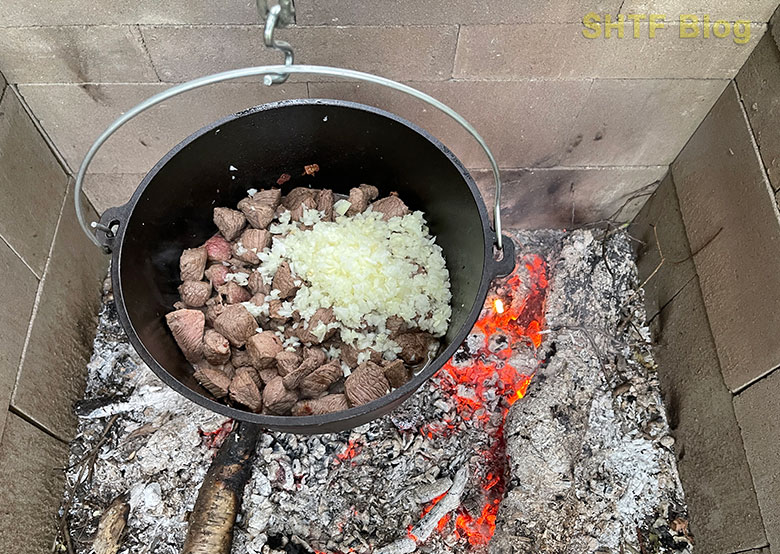
The ingredients for this recipe are not that atypical from most beef stews other than it contains bacon and does not call for flour. You can roll the meat in flour to help sear it, but I don’t bother. An alternative to this is to leave more of the bacon grease to help “sizzle” the beef. I didn’t do that either, but adjust the method to suit your style.
Other than the bacon, the recipe has standard beef stew ingredients: boneless beef chuck, potatoes, onion, garlic, tomato paste, beef stock, carrots, celery, and spices (rosemary, thyme, salt, and pepper). Optional ingredients are Worcestershire sauce or red wine (I didn’t use either).
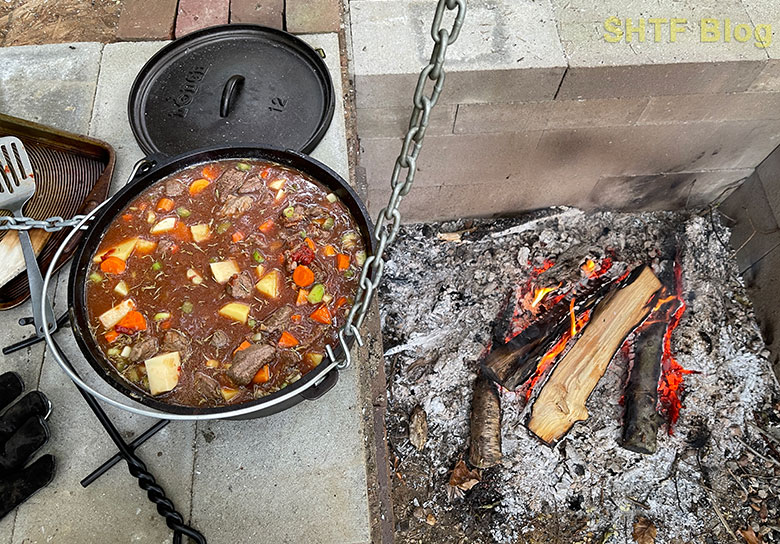
Simmering your stew is where the tricky part comes in. Ideally you want to simmer it for a few hours, but the heat level can change dramatically over a two-hour period, so you have to monitor the simmer. Cook it too high and the meat will toughen. Cook it too low and it will take longer.
You may have to check your simmer more often than you would on a modern stove. With practice campfire cooking will get easier. Of course, this recipe can also be performed right on a kitchen stove if that’s your preference.
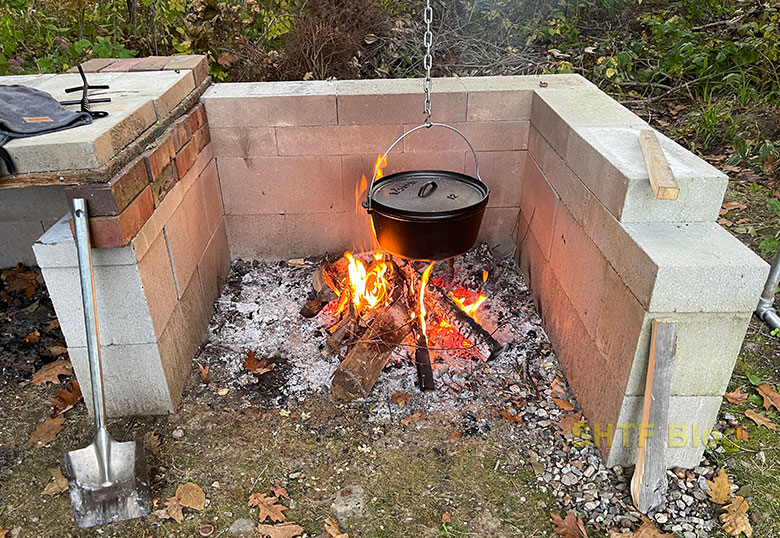
Backyard Dutch Oven Beef Stew Recipe
Being entirely honest, beef stew is not my favorite dish. I made this recipe for others, and relied on them to judge it. Knowing people can be biased when complimenting the chef, I based their “real” opinion by how much was eaten.
They put a hurt on it! My teenage son came back for second and even third helpings, eating it again for breakfast the next day.
If I was doing it over again I’d have allowed more time on the front end. It’s easy to misjudge time when cooking over a fire because you are accustomed to indoor cooking and forget how much time prepping the outdoor space and fire takes.
I didn’t give the stew the full two-hour simmer I’m recommending here, because by the time everyone was hungry I had to take it off, which meant it simmered for over an hour, but not two hours. The meat needed a tad more time to soften. Still, there were no complaints with the end product!
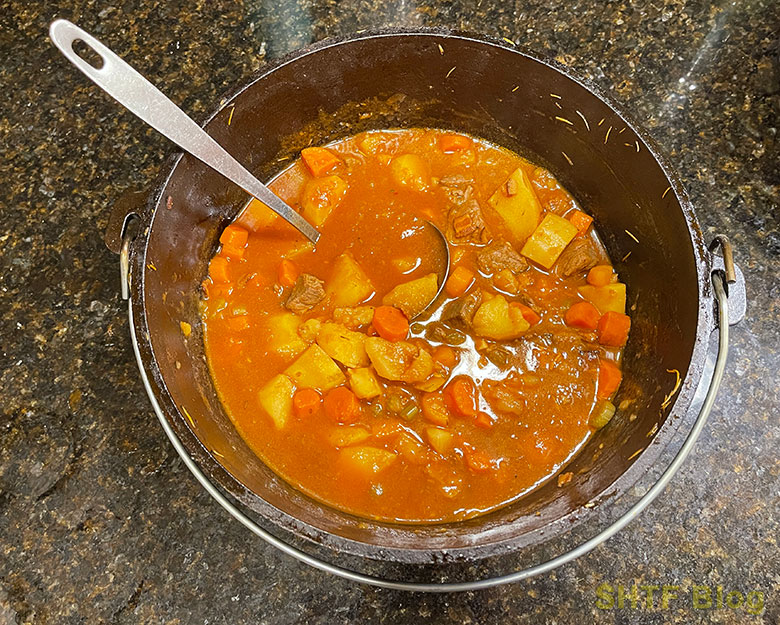
Mind your fire! Too much heat when the stew should be simmering will toughen the meat. Plan more time than you need for the recipe. Simmering longer is better than ending it soon because everyone is hungry.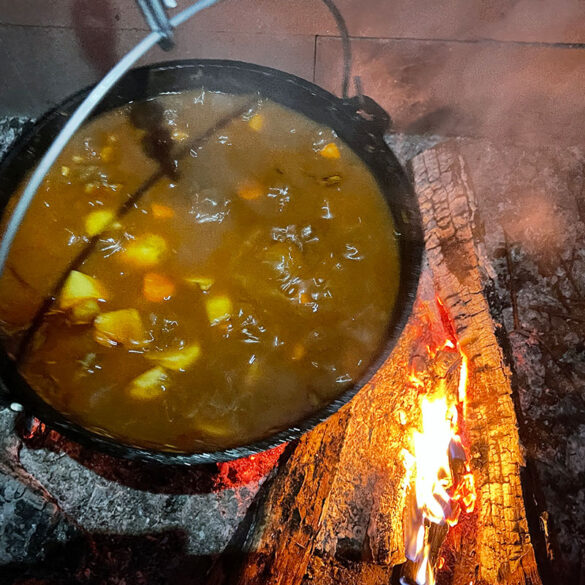
Ingredients
Instructions
Notes
What’s Your Favorite Beef Stew Recipe?
Have you tried this recipe? Do you have a favorite beef stew recipe to share? Sound off with your thoughts, comments, and suggestions below.
Want to try other Dutch oven recipes? Check out The Camp Dutch Oven Cookbook by Robin Donovan.
- Donovan, Robin (Author)
- English (Publication Language)


